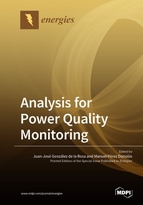Analysis for Power Quality Monitoring
A special issue of Energies (ISSN 1996-1073). This special issue belongs to the section "F: Electrical Engineering".
Deadline for manuscript submissions: closed (30 September 2019) | Viewed by 40780
Special Issue Editors
Interests: power quality; big data; smart instruments; computational intelligence for measurement systems; electronic instrumentation; higher-order statistics; non-destructive testing; statistical signal processing
Special Issues, Collections and Topics in MDPI journals
Special Issue Information
Dear Colleagues,
The Guest Editor is inviting submissions for this Special Issue of Energies on the subject area of “Analysis for Power Quality Monitoring".
Power Quality (PQ) analysis is evolving continuously mainly due to the incessant growth and development of the smart grid, and the incipient Industry 4.0 which demands quick and accurate tracking of supply dynamics. At first instance, we found structural issues, with numerous distributed energy resources and loads, whose highly fluctuating demands alter the ideal power delivery conditions. Then we had to consider the huge amount of data (big data), generated by the measurement equipment deployed during the monitoring campaigns. Data are usually difficult to interpret and manage for different reasons, for example, complex structures and communication protocols that hinder accessibility to storage units, and the limited options of monitoring equipment, based on regulations that do not reflect the current operation.
A bad PQ can have serious consequences from an economic, human or technological point of view. Indeed, more and more works demand customer-oriented PQ assessment and measurement equipment; an issue that leads inexorably to the concept of temporal and spatial scalability. Differences in load sensitivity demand certain contractual conditions, introducing thresholds that allow claiming against eventual contractual breaches. Certainly, domestic easy-to-handle instruments should incorporate elements of indication and visualization that do not require too much technical knowledge. Also, companies demand ad hoc PQ assessment. Industry research benchmarking reports would allow performance comparison of PQ metrics; hence, quantifying losses and the proposal of compensation strategies are key factors. The benefits on human safety and equipment life are also obvious.
All in all, this Special Issue aims to gather research papers and reviews dealing with the latest advances in PQ analysis, comprising ad hoc signal processing techniques, artificial intelligence and soft computing, big data analytics and cloud computing for the smart grid, development of new PQ indices, monitoring with newly PQ graphical representations, and their practical implementation in measurement equipment. As a novelty, this issue also pays special attention to the human, technological and financial consequences of a bad PQ, welcoming economic and techno–economic works focussing on losses and the financial effects of PQ mitigation plans. Topics of interest for publication include, but are not limited to:
- Power quality and reliability,
- Statistical signal processing applied to PQ,
- Intelligent methods for PQ analysis,
- PQ indices and thresholds,
- Customized PQ for utilities, customers and specific areas,
- Big data in the smart grid: compression and temporal scalability,
- Modelling and forecasting of PQ time-series,
- PQ monitoring systems: architectures and communications,
- New tendencies in smart instruments for PQ,
- Sensors networks for PQ monitoring,
- Graphical visualization of PQ,
- PQ losses assessment and mitigation,
- Economic impact of bad PQ losses,
- PQ maintenance strategies in networks,
- Industry research benchmark reports on PQ metrics,
- Prospective introduction of new PQ monitoring norms and standards.
Prof. Dr. Juan-José González de la Rosa
Guest Editor
Manuscript Submission Information
Manuscripts should be submitted online at www.mdpi.com by registering and logging in to this website. Once you are registered, click here to go to the submission form. Manuscripts can be submitted until the deadline. All submissions that pass pre-check are peer-reviewed. Accepted papers will be published continuously in the journal (as soon as accepted) and will be listed together on the special issue website. Research articles, review articles as well as short communications are invited. For planned papers, a title and short abstract (about 100 words) can be sent to the Editorial Office for announcement on this website.
Submitted manuscripts should not have been published previously, nor be under consideration for publication elsewhere (except conference proceedings papers). All manuscripts are thoroughly refereed through a single-blind peer-review process. A guide for authors and other relevant information for submission of manuscripts is available on the Instructions for Authors page. Energies is an international peer-reviewed open access semimonthly journal published by MDPI.
Please visit the Instructions for Authors page before submitting a manuscript. The Article Processing Charge (APC) for publication in this open access journal is 2600 CHF (Swiss Francs). Submitted papers should be well formatted and use good English. Authors may use MDPI's English editing service prior to publication or during author revisions.
Keywords
- power quality (PQ) and reliability monitoring systems
- statistical signal processing
- intelligent methods for PQ analysis
- PQ indices and thresholds
- customized PQ for utilities and customers
- big data in the smart grid: temporal and space compression and scalability
- graphical PQ
- PQ mitigation
- PQ losses assessment
- economic impact of bad PQ losses
- PQ maintenance strategies in networks
- new tendencies in smart instruments for PQ
- PQ norms







